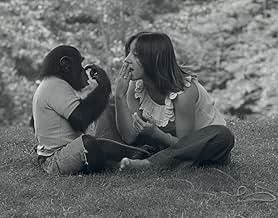Ajouter une intrigue dans votre langueTells the story of a chimpanzee taken from its mother at birth and raised like a human child by a family in a brownstone on the upper West Side in the 1970s.Tells the story of a chimpanzee taken from its mother at birth and raised like a human child by a family in a brownstone on the upper West Side in the 1970s.Tells the story of a chimpanzee taken from its mother at birth and raised like a human child by a family in a brownstone on the upper West Side in the 1970s.
- Réalisation
- Scénario
- Casting principal
- Nomination aux 1 BAFTA Award
- 16 victoires et 30 nominations au total
- Self
- (images d'archives)
- Self
- (images d'archives)
- Self
- (as Dr. James Mahoney)
- Self
- (images d'archives)
Avis à la une
What instead results is indeed a spectacle to witness. Nim is indeed a remarkable chimp who was sadly the victim of human inexperience with supplying the type of care he needed and deserved. What we learn is not what a chimpanzee is lacking, but what humanity is.
I suggest watching the film with a mind towards what Nim himself must be thinking as you see his life unfold. Nim lives a chimpanzee's analog to a human life, but for a chimp, it is utterly horrifying to watch. But like any life, there are more lighthearted moments as well, such as Nim and his friend Bob with their "Stone." "Smoke." "Now." time together, which actually seemed to be Nim's best time with any humans.
All in all, this documentary of Nim's life serves as a reminder that mother nature made chimpanzees and humans their own devices for communicating and living separately. The two cannot co-exist peacefully within one habitat due to the gap in strength and cognitive intelligence. However this one chimp, Nim, came remarkably close to peaceful co-habitation and viable communication with humans and his cost for such was great.
There is a huge amount going on in this documentary as the carers over the years are interviewed with footage from the time. What emerges will probably anger and sadden most viewers. Though I felt that Nim's carers genuinely bonded with him what emerges is a largely a tale of careless cruelty.
Equally interesting and perhaps the root cause of what happens later is the relationships between the humans. Particularly between the project leader Professor Herbert Terrance and the numerous attractive research assistants. There are several references to the power he held and exercised. Overall it has to be said he does not emerge from this film as either likable or particularly competent.
The various approaches of the teachers and carers differ so widely and even though there is much happy footage you have to wonder at the effect this had on Nim. I was left with the feeling that he eventually responded best to the people who recognised him as a chimp but still treated him as a companion within the limits this imposed.
This is a powerful film that should be shown as widely as possible and would probably be good thing to included in school curricular.
The very idea of a chimp being brought up in human society is a fascinating one. But it quickly becomes apparent that this experiment is doomed to failure. There is a very good reason that you do not see people keep chimpanzees as pets – they can be extremely aggressive and powerful animals. On numerous occasions carers were bitten and maimed. One woman had a hole ripped in the side of her face while another had her head repeatedly beaten off the pavement by the ape. But the over-riding feeling engendered by the documentary is one of sadness. This poor creature is let down by those who took him from his mother and decided to rear him as a human. It seems to me quite outrageous that an animal taught to communicate with people and live in a house should ever have been sent to an animal experiment centre. The blame must surely be primarily put on Professor Herbert Terrace whose project it was. Once Nim was sent to a chimp reserve he seemingly lost interest and made absolutely no attempt to save him from what could have quite easily have been an awful fate. So thank heavens for Bob Ingersoll the man who looked after Nim in the reserve and never gave up on him. Bob ultimately saved him through perseverance and considerable effort. He emerges as the human hero of the film, although the other carers from New York such as Laura and the young couple who followed her also cared deeply for the animal too, the latter two still seemed genuinely pained by how Nim was ultimately treated.
The essential message of the film is that you should not try to transport a wild animal into human society and not expect repercussions. Some of the people in the film are just guilty of naivety, dangerous as it was. As much as a story about a remarkable primate, it's a story about human stupidity, human callousness and – thanks to Bob Ingersoll – human kindness. It's overall a remarkable documentary.
The story starts out well, with the impossibly cute baby chimp brought up as a human. Soon, though, the behaviour of some of the "scientists" looking after Nim begins to grate; some of them are a little too involved with their subject, while others are plain creepy. Later, Nim suffers a huge betrayal, and at this point the documentary takes a downward turn into one of the most depressing ever.
Hardly a heartwarming story then, in that it focuses on misery and despair for the majority of the running time, but nevertheless an important story that serves to highlight man's inhumanity towards the world he inhabits.
Sure it has a fascinating subject in the chimp Nim, but the more fascinating subjects are the humans who inhabit his life. From the professor who never saw Nim as any more than a subject. To the family who yearn to reconnect with him. And finally people who would rescue him from isolation. The camera really turns away from the animal back to all of us as a species.
Le saviez-vous
- AnecdotesVeteran primate choreographer and actor Peter Elliott actually met and worked with Nim Chimpsky when he was researching chimpanzees for Greystoke, la légende de Tarzan (1984). He also met and worked with another famous signing chimp by the name of Washoe.
- Citations
Herbert Terrace: Wouldn't it be exciting to communicate with a chimp and find out what it was thinking? If they could be taught to articulate what they were thinking about, this would be an incredible expansion of human communication, and possibly give us some insight into how language, in fact, did evolve.
- ConnexionsFeatured in Maltin on Movies: Harry Potter and the Deathly Hallows: Part 2 (2011)
- Bandes originalesCollide
Written by Autumn Rowe
Meilleurs choix
- How long is Project Nim?Alimenté par Alexa
Détails
Box-office
- Montant brut aux États-Unis et au Canada
- 411 184 $US
- Week-end de sortie aux États-Unis et au Canada
- 25 820 $US
- 10 juil. 2011
- Montant brut mondial
- 612 839 $US
- Durée1 heure 33 minutes
- Couleur
- Mixage
Contribuer à cette page




























